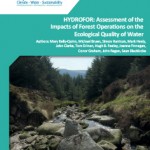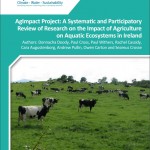The EPA has published the results of the HYDROFOR research…
Eco Eye: Community Water
Anja Murray and the Eco Eye team journey through Ireland in this episode looking at what communities around Ireland are doing to look after their local rivers and lakes. This episode looks at some of the causes of pollution putting pressure on these sensitive ecosystems, and possible solutions.
The Liffey Head Bog, and current status of our waters
The episode starts in the Liffey Head Bog and Lough Dan in the Wicklow Mountains. This area is where The Liffey, Dargle, Dodder and Glencree rivers all rise here. Its’ a Special Area of Conservation and hugely important as it is a source for Dublin’s drinking water.
Anja Murray and Sinead O’Brien from the Sustainable Water Action Network discuss the current status of our waterbodies.
About half of our rivers and lakes are at good status – if you want to learn more, this site includes a dashboard that summarises the status of our rivers and lakes
One size fits all solutions won’t work – we need the involvement and knowledge of locals
You can see Jenny Deakin from the EPA Catchments Unit talking about how we want to get local communities involved, and how given the unique nature of our local catchments one size fits all approaches won’t work everywhere – and how it is key that local communities get involved in managing their local rivers and lakes.
Agriculture and Forestry
Sources of pollution for our rivers and lakes include agriculture and forestry – You can read some EPA-funded research about the impacts of agriculture and forestry if you want to find out more.
Forestry can also be an important part of the solution, especially if the right trees are planted in the right place. The Forest Service will pay for planting trees like this under the Native Woodland Scheme. In this episode, Anja talks to Declan Little from the Native Woodland Scheme, who describes how these trees can be used as a buffer strip beside rivers – both protecting the water, and enhancing the beauty of the area.
Constructed Wetlands – enhancing water quality and biodiversity
You can also see the innovative Tolka Valley Integrated Constructed Wetlands on this episode, a project which was led by Mary Ann Harris, Parks Superintendent in Dublin City Council. The wetlands provide benefits for water quality in The River Tolka, and habitats for species like birds.
Anglers taking ownership of the Tolka
It also has helped the Tolka recover so it can support fish after a previous pollution incident – with local angling clubs being closely involved with their river, and helping look after it. This is done with the support of people like Oisin Cahill, who helps run the Dublin Angling Initiative for Inland Fisheries Ireland .
Oisin makes the point that once people get active on the river, and think of it as theirs, they are much more active in helping look after it.
Getting locals involved – Rivers Trusts, The River Loobagh and StreamScapes
The River Loobagh in Limerick is also covered – Anne Goggin tells Anja the story of a small river that was badly damaged by a slurry spill in August 2014. While this caused the angling community heartbreak at the time, the Anglers, County Council and Inland Fisheries all got involved in a project to help restore the river, and are now considering setting up their own River’s Trust – a story we previously covered in our Catchment Case Study on The River Loobagh, and we also covered how to set up a River’s Trust for anyone who may be interested.
Last up is StreamScapes and Mark Boyden – who wants to create a sense of wonder and make people aware of the linkages between our daily actions, and our quality of life and locally environment. StreamScapes aims to Engage, Enlighten and Empower local communities to understand and help manage their own local environments by doing activities like checking the health of a local stream.
As Mark says, it is about developing a culture that cultivates “a sense of voluntary stewardship” – we are all in this together.







